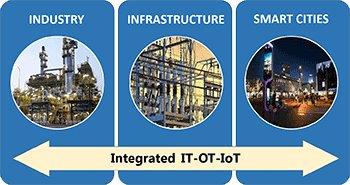

The core theme at the recent India Forum was digitalization across industry, infrastructure, and smart cities; based on a foundation of seamless and horizontal-vertical integration of IT-OT-IoT and cybersecurity. The presentations by Siemens, a global sponsor at the forum, focused on all these aspects. Siemens showcased its technologies via case studies, exhibiting the company’s expertise in multiple domains. With its global footprint, technology breakthroughs, and collaborative efforts the company is helping boost industrial growth.

Vivek Roy, Head – Industrial Communication & Identification, Process Industries & Drives, Siemens India spoke about the challenges for future-proofing and securing industrial communication networks through cybersecurity. He said that digitalization and Big Data address the key industry requirements, such as speed, flexibility, etc. Comparing the non-digital past with the digital present, he mentioned the shift from manual to automated processes; islands of automation to interoperability; legacy systems to vertical integration, etc. Digitalization connects the production and enterprise layers and these industrial networks, but critical requirements need to be addressed:
The main aspects to be considered in industrial network design are management, security, and structure; industrial security touches many points in the structure (training and policy, firewalls, virus scans etc.). At the enterprise level, the main threat is loss of data and confidentiality; at the industrial level, open networks increase potential threats. Hence, security measures are vital to protect against unauthorized access, espionage, damage, or sabotage, he said. Mr. Roy elaborated on how a holistic security concept must include technology, processes, and people. Further, he discussed the importance of standards for industrial security, because every stakeholder (asset owner, system integrator, or product supplier) can introduce vulnerabilities. IEC 62443 addresses the defense-in-depth concept that involves all the stakeholders and components (plant security, network security, and system integrity). Mr. Roy showcased “then” and “now” scenarios for an automotive manufacturer and a food and beverage customer.
Milind Kulkarni, Chief Manager-Business Development, Factory Automation, Siemens spoke about how global data access and cloud-based services enable transparent plant operations (production, equipment health, and energy data) and improved decision support. This process involves analyzing the data that is captured, visualizing the relevant information, and transforming that information into business intelligence (BI). This can be fed back into the systems and processes to take the necessary corrective actions. Having access to the past history, current status, and future probabilities helps users quickly fix problems and make informed decisions.
He showed a video in which traditional and new methods were automated in a spice mill to enhance efficiency and productivity. The main purpose of digitalization is to improve productivity; and this can be achieved by linking the horizontal and vertical value chains. He explained how reducing energy costs can help reduce the final product cost without detracting from quality. This requires continuously acquiring and analyzing energy data to optimize energy usage. Mr. Kulkarni mentioned two “DINs” that are required for plant transparency:
In this context, he spoke about the Siemens WebUX solutions that can be used to capture relevant plant information in various application scenarios (management, quality, maintenance).

